| Key Takeaways: • Kitchen splashbacks are essential for protecting walls from moisture, grease, and food splatters while enhancing kitchen aesthetics and potentially contributing to property value. • From ceramic tiles and glass panels to stone slabs and timber options, each material offers distinct benefits for various kitchen styles and maintenance requirements. |
A study showed that kitchen renovations were Australian homeowners’ number one home improvement project. Yet, many overlook one of the most crucial design decisions that can make or break the entire space: kitchen splashbacks. Splashbacks don’t just protect walls from cooking chaos; they can also transform a bland kitchen into a stunning centrepiece or, if chosen poorly, undermine even the most expensive makeover.
There are different types of kitchen splashbacks for every need and homeowner personality. This guide explores the most sought-after splashback materials among Australian homeowners, their unique properties, and the care routines that will maintain their beauty and performance for decades.
Understanding kitchen splashbacks and their benefits
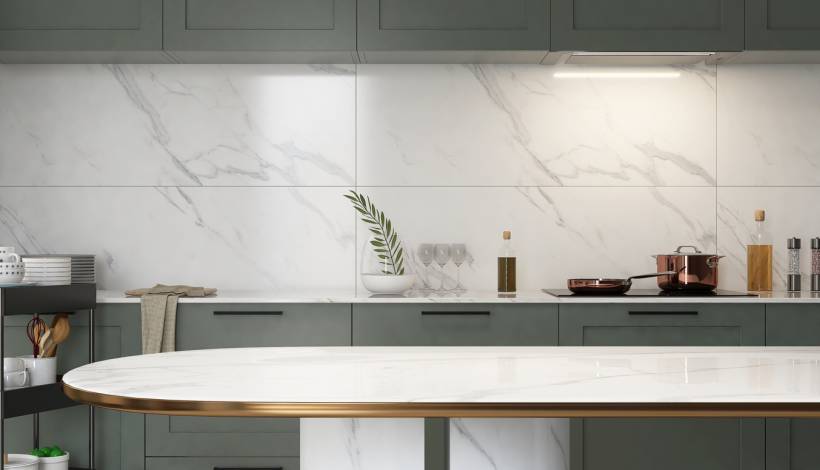
A kitchen splashback is a protective surface that goes behind cooking and prep areas and sinks, where walls face regular exposure to moisture, heat, and food particles. Beyond their primary protective function, different types of splashbacks for kitchens deliver various advantages:
Hygiene
Splashbacks provide surfaces that are easier to sanitise than painted walls, reducing bacterial growth and maintaining kitchen cleanliness standards. Their non-porous nature prevents the absorption of cooking odours and contaminants.
Aesthetics
You can choose from various splashback designs to give your kitchen visual depth. Recent trends favour earthy tones and natural textures, with materials such as stone and timber finishes bringing warmth and character to kitchen environments.
Property value
With the right and fitting splashback for your home, it can enhance your home’s market appeal and contribute significantly to returns from kitchen renovations. Quality installations show attention to detail and long-term thinking that appeals to prospective buyers.
What are the different kitchen splashback materials in Australia?
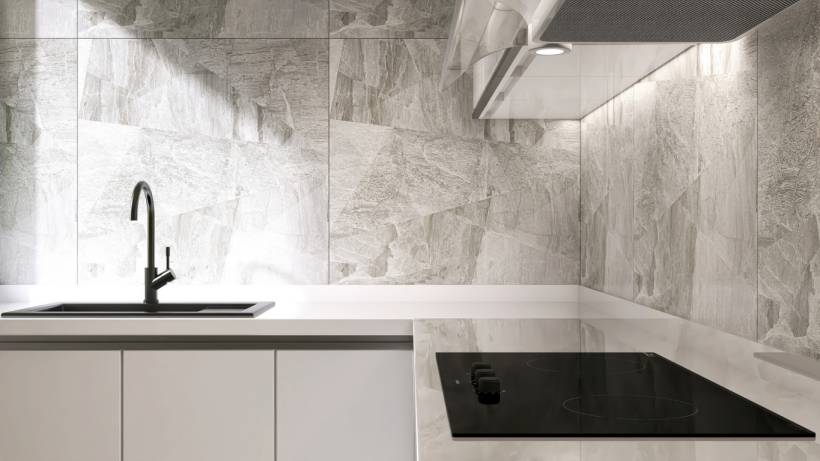
Australian kitchens showcase several types of kitchen splashbacks based on material. Each type offers distinct characteristics suited to different cooking styles, maintenance preferences, and design themes.
Ceramic and porcelain tiles
Ceramic and porcelain kitchen tiles remain popular among Australian homeowners due to their versatility and practical benefits. These tiles offer affordability, straightforward installation, and a range of classic, appealing options. Of these two, porcelain has higher water resistance, which makes it even better for particularly humid kitchens.
- Features: Both materials are highly durable, but porcelain offers superior resistance to water absorption and thermal shock. The wide variety of colours, patterns, and sizes means you can achieve any design, from understated neutrals to bold, dramatic pieces. Large-format tiles are also effective for creating clean, elegant lines with less grout.
- Finishes/Options: Ceramic and porcelain splashbacks come in high-gloss, matte, textured, or stone-look surfaces. Glossy tiles reflect light and brighten a space, while matte and textured finishes offer a softer, more tactile feel. Meanwhile, stone-look porcelain brings a luxe and natural appeal while still being durable. There are also mosaic options in various finishes and sizes that give a sleek, low-maintenance look.
- Best for: Homeowners seeking cost-effective solutions with extensive design flexibility. Tiles look great for both traditional kitchen designs, like a Hampton-style kitchen and contemporary designs.
| Pros: • Cost-effective–ceramic tiles range from $20–30/m², while porcelain tiles are around $70/m² • Easy to replace individual tiles if damaged • Good heat resistance • Simple to clean using standard household cleaners | Cons: • Grout lines can stain and need periodic retouching • Requires more upkeep than seamless surfaces (e.g. glass, stone) • Complex patterns or irregular layouts increase installation difficulty |
Glass splashbacks
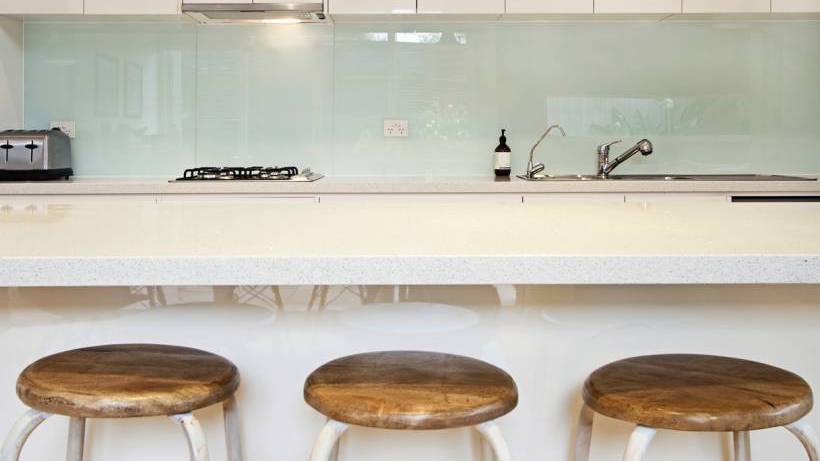
Glass is one of the most common types of splashbacks for kitchens in Australia, especially those using tempered glass for improved safety and durability. They deliver sleek, reflective surfaces that suit modern kitchens and are easy to maintain.
- Features: Tempered glass is three to five times stronger than regular glass, providing excellent durability and heat resistance. Their non-porous surface prevents water absorption, eliminating concerns about cracking, swelling, or staining.
- Finishes/Options: Available in numerous colours, including bold blues, vibrant greens, and sophisticated neutrals, with options for clear, bronze, or smoked finishes. Custom colour matching allows coordination with existing design elements.
- Best for: Contemporary kitchens that prioritise minimal maintenance over pattern variety. It’s also suitable for smaller kitchens where light reflection creates spacious illusions.
| Pros: • Quick wipe-downs remove grease, splatters, and fingerprints with ease • Superior durability with minimal maintenance • Excellent light reflection that can make small kitchens appear larger | Cons: • Higher initial costs from $30 to $120 per square metre (excluding installation) • Extended installation timeframes and professional installation requirements for measurement, fabrication, and fitting • Highly polished finishes may also create glare issues in bright spaces |
Stainless steel splashbacks
Stainless steel applications in residential kitchens create looks that feel both innovative and classic, ranging from standalone installations to comprehensive coverage across entire spaces. This material brings commercial kitchen durability to a residential setting.
- Features: Outstanding heat resistance and hygienic properties make stainless steel ideal for active cooking areas. The material resists corrosion, staining, and bacterial growth while providing contemporary industrial aesthetics.
- Finishes/Options: Available in brushed, polished, and textured finishes. Standard gauges provide adequate protection while heavier options offer enhanced durability for high-use situations.
- Best for: Contemporary kitchen designs where functionality takes precedence over decorative elements. It’s particularly suitable for serious cooking enthusiasts who value commercial-grade performance.
| Pros: • High durability, easy cleaning, and recyclability • Superior heat resistance compared to alternatives, making it ideal for gas cooktop applications • Generally costs less than premium glass or stone | Cons: • Prone to scratches, fingerprints, and watermarks, requiring careful cleaning techniques • Industrial appearance may not suit all design preferences and architecture |
Acrylic splashbacks
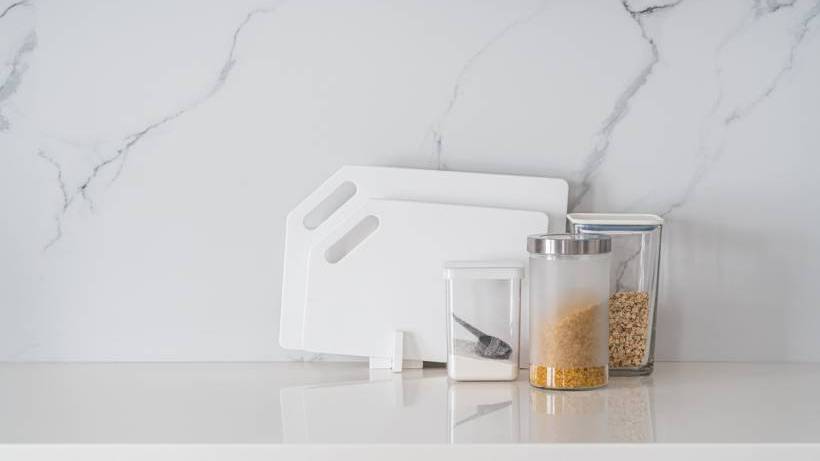
Acrylic splashbacks provide a glass-like appearance at reduced costs with simplified installation processes. For example, lustrolite is a popular high-gloss acrylic option that mimics glass while offering lightweight installation and superior stain resistance.
- Features: Lightweight construction facilitates easier installation compared to glass while maintaining a similar visual appeal. Non-porous surfaces resist staining and moisture absorption effectively.
- Finishes/Options: Available in extensive colour ranges with gloss and semi-gloss finishes. Custom colour matching accommodates specific design requirements.
- Best for: Cost-conscious renovators seeking glass aesthetics without premium pricing. It’s suitable for DIY installations where professional glass fitting exceeds budget limitations.
| Pros: • Significantly lower costs than glass with easier installation requirements • Less likely to break than glass due to its higher impact resistance • Can be suitable for DIY installation in some cases. | Cons • Susceptible to scratching, requiring careful cleaning with soft cloths and mild cleaners • Limited heat resistance compared to glass or stone alternatives—maintain appropriate distance from heat sources |
Timber and plywood splashbacks
Wood-like materials add rustic appeal and tremendous warmth to kitchen spaces, with modern moisture-resistant tiles providing natural beauty on top of the durability you demand. Professional carpenters, however, advise that if you want to use natural timber, moisture resistance should be a top priority.
- Features: Timber applications offer a minimal, warm look when applied across kitchen spaces, including cabinetry and flooring. Modern treatments enhance moisture resistance while preserving natural characteristics.
- Finishes/Options: Natural timber offers various species with distinct grain patterns and colours. Engineered options provide enhanced stability and moisture resistance while maintaining authentic appearances.
- Best for: Country-style and modern-country kitchen styles that emphasise natural materials and high-quality craftsmanship. This makes it suitable for homeowners prioritising warmth and organic textures.
| Pros: • Unique natural beauty with potential for customisation through staining or finishing • Creates an inviting, warm atmosphere that complements various design styles • Resists moisture better than untreated timber while maintaining the same aesthetic | Cons: • Requires careful sealing and regular maintenance to prevent moisture damage • Limited heat resistance; appropriate distance from cooking surfaces is necessary |
Stone splashbacks
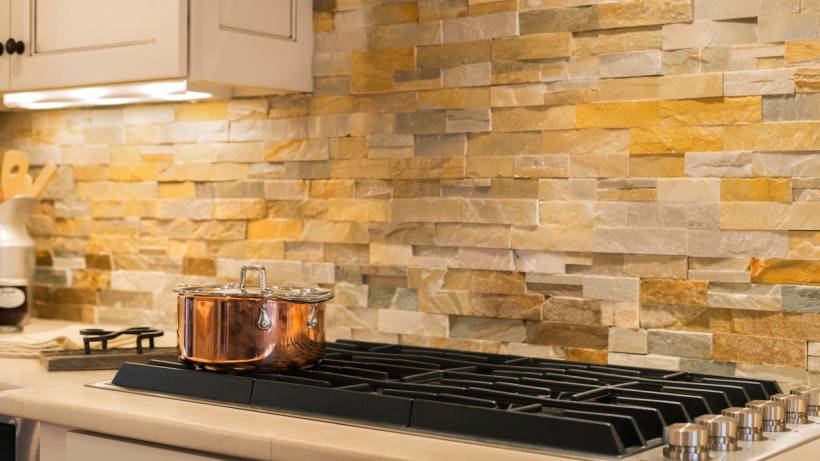
Stone splashback materials represent premium choices for sophisticated kitchen designs and work particularly well in luxury kitchen renovations.
- Features: Matching splashback and benchtop material combinations using stone create sophisticated, cohesive flows throughout kitchen spaces. Natural stone provides unique patterns while engineered options offer consistent appearances and enhanced durability.
- Finishes/Options: Stone splashbacks, particularly granite, marble, and quartz, offer durability and luxurious appearances when matched with coordinating benchtops. Natural stones showcase individual characteristics with polished, honed, or textured finishes.
- Best for: Luxury kitchen installations where premium materials justify higher investments. Consult our benchtops cost guide for more detailed cost advice.
| Pros: • Superior durability and easy maintenance with low porosity, preventing liquid and bacteria absorption • Exceptional heat and scratch resistance with long-term aesthetic preservation • Generally costs less than premium glass or stone | Cons: • Higher costs than most alternatives; professional installation for natural stone is significantly more expensive • Marble splashbacks are also soft and porous, making them susceptible to marking and staining. |
How do you maintain and clean your kitchen splashback?
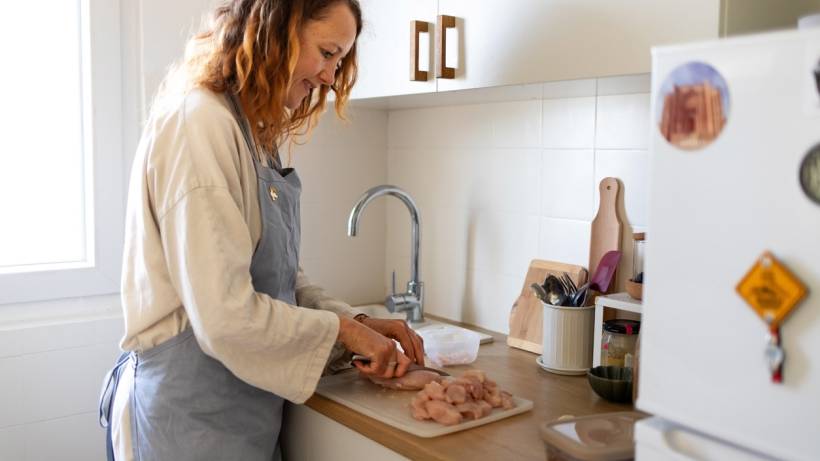
What type of splashback is best for the kitchen? The answer is the one that you can maintain. Like most things around a typical home, a splashback for the kitchen needs regular maintenance to extend its lifespan while preserving its appearance. While different materials require specific approaches, most principles apply across all installations.
Wipe spills right away
Removing spills and food splashes right away prevents permanent staining to splashbacks or grout. Developing a habit of cleaning spills as they occur maintains a splashback appearance with minimal effort.
Use appropriate cleaning materials
Your splashback material determines appropriate cleaning products, ranging from simple glass cleaners to specialised stainless steel solutions. When uncertain, water-diluted gentle dishwashing detergent provides safe cleaning for most materials. Regardless of your splashback type, avoid harsh or abrasive chemicals that can cause permanent damage.
Choose the correct cleaning tools
Using appropriate cleaning cloths maintains the splashback’s finish. Avoid abrasive options like metal or plastic scourers, which can damage or scratch surfaces. Instead, opt for lint-free cloths or paper towels to clean marks and spills. Then, after cleaning, it’s best to wipe over surfaces with a dry, clean cloth.
Clean according to cooking frequency
Heavy cooking requires daily splashback cleaning to prevent grease buildup, while weekly thorough cleaning suits moderate cooking patterns. Adjust cleaning frequency based on your cooking habits and splashback exposure.
Apply proper cleaning techniques
Use circular motions when cleaning glass surfaces to avoid streaking, rather than wiping up and down or left to right. Remember to let the cleaning solutions sit for several minutes before wiping to soften stubborn residues.
Maintain sealing and water protection
Sealing splashbacks protects them from water damage regardless of material type. Stone splashbacks require resealing every few years, while tile splashbacks need grout resealing periodically. Make sure to check the integrity of silicone borders that help maintain water impermeability, as these may need replacement over time.
How do you fix common splashback problems?
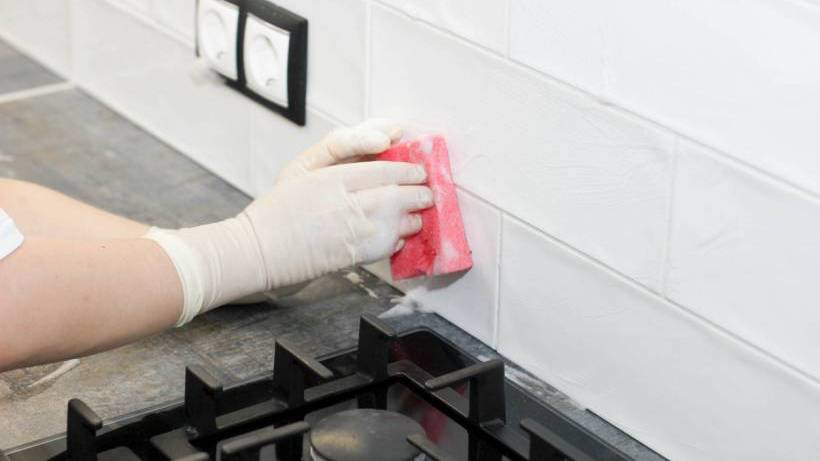
Most modern kitchen splashbacks encounter issues during their lifetime. Fortunately, they can be resolved with proper knowledge and a little elbow grease.
Grout discolouration or mould growth
- For light discolouration: Mix equal parts water and white vinegar in a spray bottle. Spray affected areas, let sit for several minutes, then scrub gently with an old toothbrush. Rinse well.
- For stubborn stains: Create a paste using baking soda, dish soap, and water. Apply to discoloured areas, allow adequate contact time, then scrub gently with a soft brush.
- For mould growth: Use appropriate mould cleaning products following the manufacturer’s instructions and ensure good ventilation. However, consider a professional assessment if mould persists, as this may indicate moisture penetration issues.
Surface scratches
- Glass splashbacks: Minor scratches sometimes improve with appropriate polishing compounds applied with soft cloths in circular motions. On the other hand, deep scratches may need professional assessment to determine if repair is more cost-effective than replacement.
- Acrylic surfaces: Light scratches may respond to gentle polishing with appropriate products designed for acrylic surfaces.
- Stainless steel: Buff minor scratches following the grain direction using appropriate stainless steel care products and microfibre cloths. Unlike glass, avoid circular motions when polishing stainless steel surfaces, which can worsen the appearance.
Surface stains
- Oil and grease stains: Apply baking soda paste to stained areas, allow adequate contact time, then remove gently with a soft cloth.
- Hard water marks: Mix equal parts white vinegar and water, apply to marks, wait several minutes, then wipe clean. For persistent marks, lemon juice provides natural acidity.
- Food stains: Address them right away with a dish soap solution. For set stains, check the manufacturer’s recommendations for appropriate cleaning methods.
Chips/cracks
- Ceramic/porcelain tiles: Small chips can often be concealed with colour-matched repair compounds available from tile suppliers. Clean the area, apply according to manufacturer’s instructions, and allow adequate curing time before cleaning.
- Glass splashbacks: Any crack compromises structural integrity. Stop using the area right away and contact professionals for assessment. Temporary measures may prevent the issue from worsening until a professional can inspect the problem.
- Stone surfaces: Minor chips may be repairable with suitable products, though professional assessment often provides the best guidance for matching patterns and achieving proper finishes.
Choose the right kitchen splashback for your home
Strike a balance between your preferences, commitment to maintenance, and budget. In addition, how often you cook matters, as premium materials like natural stone offer beauty and durability but demand higher maintenance and a greater upfront investment.
Connect with trusted kitchen renovation experts who can guide you through material selection, design planning, and professional installation to create the kitchen of your dreams. For comprehensive pricing information, explore our detailed kitchen renovation costs guide to help budget your project effectively.
FAQs on kitchen splashbacks
Can I put a new splashback over old tiles?
Installing splashbacks over existing tiles is possible in many situations, provided the current surface remains firmly attached and level. The additional thickness may require adjustments to electrical outlets and trim pieces. A professional assessment will help ensure proper adhesion and long-term stability.
When planning installation, consider what’s included in quotes, warranty coverage, and whether building inspection compliance documentation is required. For electrical modifications, work with qualified electricians to ensure safe compliance with Australian standards.
How high should a kitchen splashback be in Australia?
Standard Australian practice installs splashbacks at 600mm above benchtop surfaces for electric and induction cooktops, though newer rangehood manuals often recommend 650mm regardless of cooktop type.
Note that areas behind gas cooktops require specific clearance considerations due to safety regulations outlined in Australian Standard AS/NZS 5601.1. For gas cooktop installations or modifications, consult a licensed plumber who understands these compliance requirements.
What is the most durable splashback material for a busy kitchen?
Quartz and porcelain offer exceptional durability with heat, stain, and scratch resistance, making them ideal for active cooking environments. Both materials provide easy maintenance while withstanding heavy daily use without compromising appearance. For comprehensive durability comparisons, explore our kitchen benchtop materials guide.
What’s the difference between ceramic and porcelain splashback tiles?
Porcelain tiles absorb less water than ceramic alternatives, making them more suitable for high-moisture kitchen environments. Porcelain also demonstrates superior durability and stain resistance, though ceramic tiles offer broader design variety at lower costs.
Do stone splashbacks need to be sealed in Australia?
Natural stone splashbacks require periodic sealing every two to three years to maintain protection against moisture damage and staining. Engineered stone alternatives often require less frequent sealing due to their dense structure and consistent composition.

















